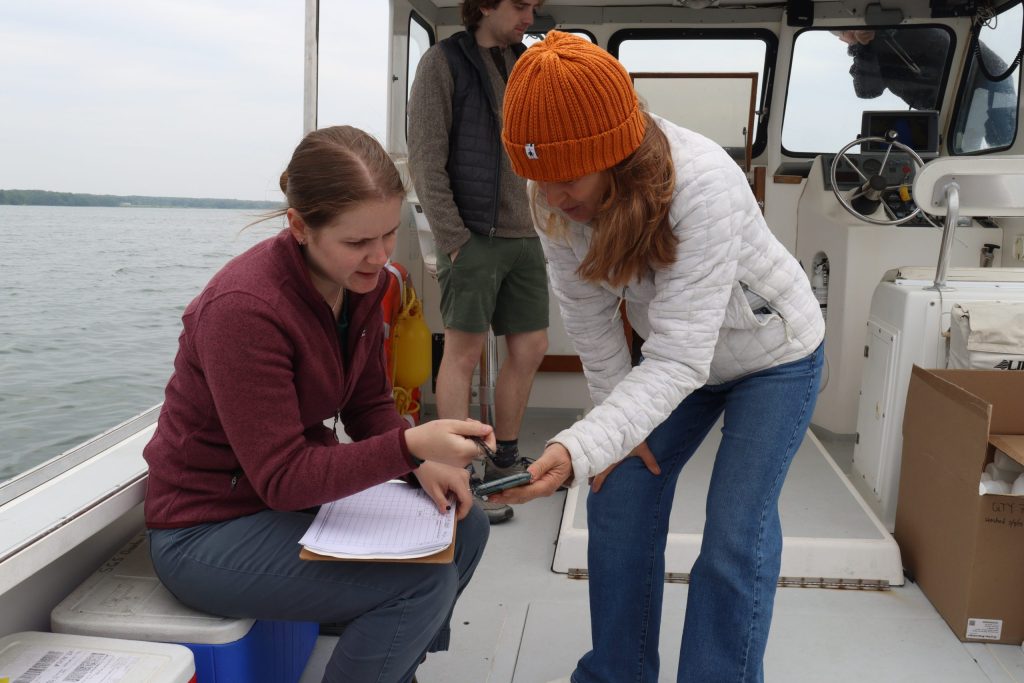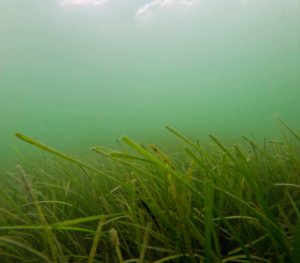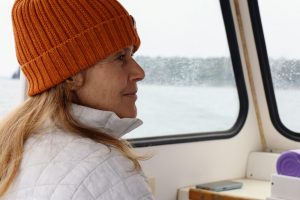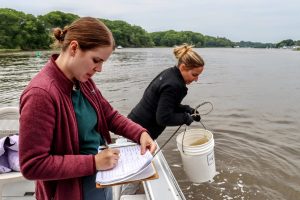
By Casco BAYKEEPER® Ivy Frignoca
From April to October, our team spends long days on Casco Bay, collecting samples and observing conditions. While busy gathering data, we can’t help but delight in nature’s abundance. This season, the Bay teemed with playful porpoises, superabundant seals, ginormous jellyfish, and soaring sturgeon. When the field season ends, we crunch the data. While the full results are still to come, here are a few discoveries that stood out:
Winter Snow Leads to Less Salty, Cooler Waters in Spring: Mike and I wondered how the snowy winter and rainy spring of 2025 would affect the Bay. In early June, I ate delicious oysters from just outside the Royal River that tasted less briny than usual. Days later, our monitoring confirmed that fresh water from the river had made the Bay less salty. We also recorded cooler water temperatures than in recent years. It’s natural and good for an estuary to receive nourishing fresh water, but we’re curious to see how extremes—periods of excess water followed by drought—will affect the Bay in coming years.

Eelgrass: To Be or Not to Be: Our final year of the pilot project began with high hopes as last fall’s seeds grew into shoots! Some of that growth was lost later in the summer, but the lessons we’ve learned will guide us and our partners in new monitoring and transplanting efforts under a second eelgrass restoration grant next summer.
PFAS, from the Watershed to the Bay: This summer, we wrapped up our PFAS study after sampling 76 water sites and 45 sediment sites. Our partners at Bigelow Laboratory for Ocean Sciences are analyzing the samples. We’ll share results with you this winter. In the meantime, check out this story for a behind-the-scenes peek at the study through two key team members.
Nuisance Algal Blooms—those pesky green mats that smother beaches and clam flats: In early summer, our volunteer Water Reporters spotted small blooms at Mill Cove, Willard Beach, and Mackworth Island. By the end of August, those blooms had spread, coinciding with the late-summer drought—a pattern we’ve seen in past dry years.
Real-Time Data: Our three Continuous Monitoring Stations are year-round workhorses, collecting data every 15 minutes, allowing us to track the Bay’s health, including ocean acidification. Thanks to the new telemetry equipment at our Harpswell site, data now beams directly to us in real-time. The telemetry helps ensure quality data. You can check out our live data portal here.
The 2025 field season was filled with teamwork, curiosity, and discovery. Each day on the water deepens our connection to Casco Bay and builds the knowledge we need to support its resilience.
Thank you to Friends of Casco Bay members who make all of our work possible. Special thanks to Casco Bay Estuary Partnership for supporting our Continuous Monitoring Stations and funding our telemetry. Thank you to Beacon Analytical Systems, Evolved Movement, and Horizon Foundation for their support of our monitoring efforts. Thank you to Bigelow Laboratory for Ocean Sciences for its partnership in our PFAS research.


